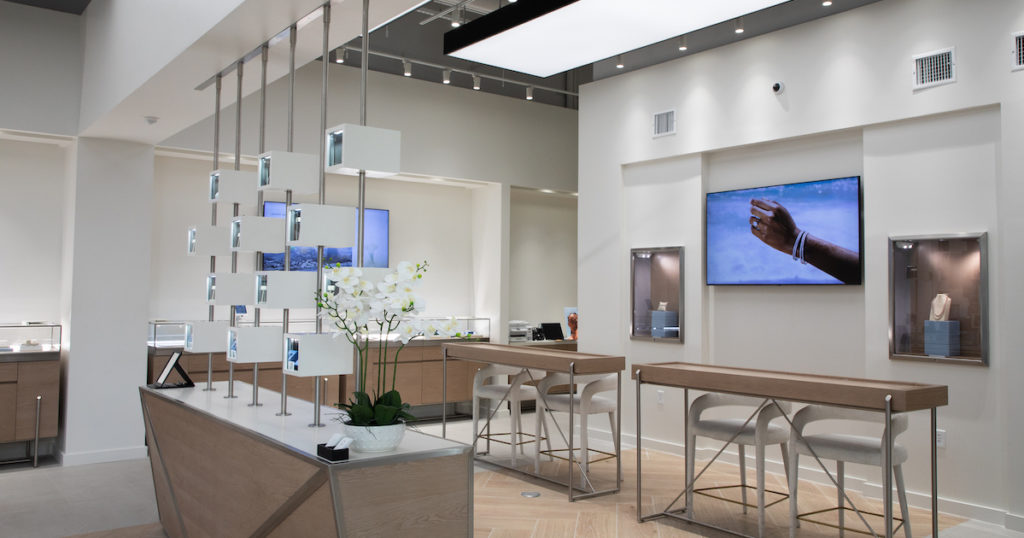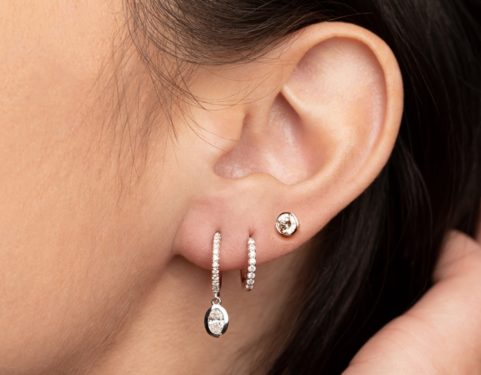Getting your ears pierced is a great way to show off your style and personality. But you need to know when to switch up your earrings for a smooth healing journey. In this blog post, we’ll dig into all the stuff that affects how your ear piercings heal. We’ll talk about when it’s the right time to change your earrings depending on your piercing type, and we’ll share tips for picking out the perfect jewelry and taking care of your piercings. By the time you finish reading, you’ll be a pro at answering the question, “When can I change my ear piercing?” and keeping those ears looking flawless!
Key Takeaways
- Understanding the ear-piercing healing process is essential to successful healing.
- Factors such as the type and location of the piercing, individual health factors, and aftercare practices affect healing time.
- Signs that an ear piercing has healed include lack of pain or sensitivity and healthy skin appearance around a pierced area with no inflammation or discharge.
- It is recommended to consult a professional piercer before making any changes.
Understanding the Ear Piercing Healing Process

The journey to healed ear piercings passes through three important phases. First comes the inflammatory stage, where the initial wound triggers swelling and redness as your body sends healing cells to the area. Next is the proliferative stage, which involves the formation of new tissue to close the piercing. Collagen production ramps up to repair the wound. Finally, the remodeling stage reorganizes the new collagen fibers and tissue for optimum strength.
Inflammatory Stage
In the first days after piercing, swelling, redness, and tenderness signal that inflammation has begun. The body rushes defensive cells to the wound, starting the healing process. Discomfort is normal during this 2-3 day phase. Help the process by gently cleaning with saline solution and avoiding pressure on the piercing.
Proliferative Stage
Over the next weeks and months, the proliferative phase kicks off. The body works to repair the piercing, generating new skin cells and blood vessels. Careful cleaning and protection from irritation are vital now to prevent infection and support healing.
Remodeling Stage
The final phase, starting around 6 months post-piercing, matures the tissue around the piercing. Lasting up to 2 years, this remodeling stage firms up the piercing site. Stay diligent in your aftercare routine during this stabilizing process. Limit jewelry changes and keep the area clean.
Factors Affecting Ear Piercing Healing Time

Multiple factors shape ear piercing healing times. The type and location of the piercing, individual health, aftercare diligence, jewelry quality, and lifestyle all play a role in determining how fast piercings recover.
Piercing Type and Location
Not all ear piercings are equal when it comes to healing needs. The body part pierced and the type of jewelry affect recovery time. For instance, nose piercings and cartilage piercings, such as the septum and tragus, typically require a longer healing period, ranging from 2 to 8 months until complete healing is achieved.
Individual Factors
Your own health profile shapes healing too. Those with allergies or weaker immune systems may find piercings take longer to recover from inflammation and infection risks. Overall wellness supports faster, smoother healing.
Aftercare Diligence
The healing time of your ear piercing heavily depends on proper aftercare practices long after ear piercing. Regular cleaning, avoiding irritants, and proper earring handling give piercings the best chance to heal quickly.
When to Change Your Earrings Based on Piercing Type

When changing earrings, it’s important to wait until piercings are fully healed to avoid irritation or infection. Use these general guidelines for various piercing types:
- Ear lobe Piercings: Wait at least 6-8 weeks before changing earrings in healed earlobe piercings. The lobes tend to heal quickly, but give them adequate time to close up before swapping jewelry.
- Cartilage Piercing: Let piercings in the helix, tragus, and other ear cartilage heal for up to 12 weeks before changing earrings. Cartilage is thicker than earlobe tissue and takes more time to heal completely.
- Unique Piercings: For rare piercings like the anti-tragus, daith, or industrial, consult your piercer on ideal timelines. These piercings have specific anatomy considerations.
While these healing process timeframes serve as useful benchmarks, healing time varies from person to person. If you’re unsure if your piercing is ready for new earrings, check with your piercer first.
Choosing the Right Jewelry for Your Ear Piercing

Selecting the proper piercing jewelry is crucial for ensuring your ear piercing heals smoothly and comfortably. Consider these key factors when choosing earrings:
Hypoallergenic Materials
Opt for jewelry made from titanium, 14-karat gold, surgical-grade steel, and other hypoallergenic metals. These reduce irritation and allergic reactions. Avoid jewelry with nickel or sterling silver.
Comfortable Style
Choose earrings with a simple, rounded, or smooth style that won’t put pressure on the piercing as it heals. Avoid sharp edges or ornate shapes.
Proper Size and Fit
Select jewelry that fits your piercing comfortably without being too tight or loose. Ill-fitting earrings can cause irritation, migration, or swelling. Consult your piercer for sizing recommendations.
Ease of Removal
Pick earrings with a secure back or post so they don’t fall out easily, but are still easy to remove for cleaning during healing. Avoid screw-backs or overly tight closures.
Take your time selecting the right earrings that prioritize comfort, hypoallergenic material, and proper fit. Consult your piercer at the piercing shop for guidance on selecting the appropriate size for your specific piercing type, and always prioritize comfort and proper fit over aesthetics. Once healed, you can switch to more decorative or stylized jewelry that expresses your personal flair.
Ear Piercing Aftercare Tips for Faster Healing

Adhering to proper aftercare is key to ensuring a smooth and healthy healing process for your ear piercings. Following a few easy steps can help in making sure your piercing heals faster and perfectly.
Cleaning Your Piercing
Maintaining the cleanliness of your piercing is vital to avoid infection and promote proper healing. Clean your piercing regularly with a saline solution or an appropriate cleaning product, such as a mild, fragrance-free cleanser and water. Avoid using alcohol or other harsh chemicals, as these can cause irritation and delay healing. Make sure to clean both the front and back of the piercing, as well as the jewelry itself, to ensure a bacteria-free environment.
Avoiding Irritants
For quicker healing, steering clear of irritants like perfumes, lotions, and harsh chemicals around your piercing is necessary. These products can cause inflammation, irritation, and even infection, which can delay the healing process. Instead, opt for fragrance-free, gentle products and keep the area around your piercing clean and dry.
Handling Your Earrings
Throughout the healing process, careful handling of your earrings and avoiding unnecessary touching or rotating is important. Always wash your hands with soap and water before touching your earrings or the piercing site, and avoid tugging or pulling on the jewelry. If you need to change earrings or adjust them, do so gently and carefully to prevent irritation or damage to the healing piercing.
Signs Your Ear Piercing is Ready for a Change

Changing your earrings too soon can interrupt the healing process and lead to problems. Look for these signs to know your piercing is fully healed and ready for new jewelry:
Lack of Pain or Sensitivity
A clear indication that your ear piercing is prepared for a change is the absence of pain or sensitivity when manipulating the earrings or touching the piercing site. If you can comfortably touch and move your earrings without experiencing pain or discomfort, your piercing is likely healed and ready for a change. However, it’s always best to consult your piercer if you’re unsure, as individual healing times may vary.
Healthy Skin Appearance
Another sign that your new piercing is ready for a change is the presence of healthy skin around it. If the skin around your new ear piercings appears normal, without redness, swelling, or discharge, your new piercings are likely healed and ready for new earrings. It’s essential to monitor your piercing throughout the healing process and consult your piercer or a healthcare professional if you notice any signs of infection or complications.
No Inflammation or Discharge
Another sign that your healed piercing is ready for a change is the lack of inflammation or discharge around it. If there’s no pus, crust, or other discharge around your piercing and the area isn’t red or swollen, your piercing is likely healed and ready for new earrings. As with other signs, it’s essential to consult your piercer or a healthcare professional if you’re unsure or if you notice any signs of infection or complications.
TL;DR

Changing your earrings at the right time is key for a successful piercing experience. Be patient and allow adequate healing time before swapping jewelry – up to 6-8 weeks for earlobes and 6-12 months for cartilage. Signs your piercing is healed include no pain, normal skin, and lack of discharge. Unique piercings require guidance from your piercer on ideal jewelry change timelines. Proper aftercare, like cleaning and not touching the area, facilitates the healing process. However, healing varies from person to person. If ever unsure, consult your piercer first before attempting an earring change. With some patience and by following your piercer’s expert advice, you’ll know when the time is right to safely change your earrings.
Find the Perfect Pair of Earrings at Clean Origin

Clean Origin is the perfect destination for finding the perfect pair of earrings. We offer a wide range of high-quality and ethically sourced earrings that are sure to meet your style and budget preferences.
Whether you’re looking for something simple and classic like stud earrings, or something bold and unique like hoops, we’ve got you covered. With our commitment to sustainability, you can feel good about your purchase knowing that it was made with the environment in mind.
So, why wait? Schedule a virtual appointment with one of our team members or visit a showroom in a city near you today!



